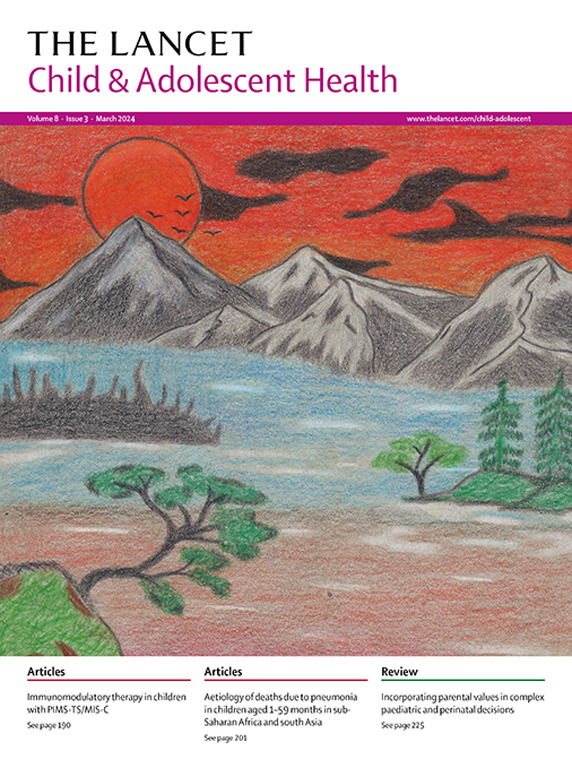针对泰国青少年的减量重组百日咳疫苗强化剂:一项第 2/3 阶段、观察者盲法、随机对照、非劣效试验。
IF 19.9
1区 医学
Q1 PEDIATRICS
引用次数: 0
摘要
背景:百日咳的再次流行增加了对低成本疫苗的需求。本研究的目的是测试含有减量(2 μg)重组百日咳毒素(PT)和 5 μg 丝状血凝素(FHA.apgen)的加强型无细胞单价百日咳疫苗与含有破伤风和减量白喉类毒素(百白破)的apgen疫苗的免疫原性;apgen)与含有破伤风类毒素和减量白喉类毒素的 apgen 版本(Tdapgen)以及含有化学解毒 PT 和 FHA 与破伤风类毒素和减量白喉类毒素复合物的许可疫苗(Tdapchem)进行对比。研究方法在泰国曼谷和巴吞他尼(Pathum Thani)的两个临床研究中心对 9-17 岁的青少年进行了这项第 2/3 期、观察盲、随机对照、非劣效试验。对符合条件的参与者进行筛选并随机分配(1:1:1),让他们接种一剂阿普根、百白破或百白破混合疫苗。对参与者进行随访,直至免疫后第 336 天。主要终点是百白破疫苗组和百白破疫苗组的血清转换率无劣效性,血清转换率定义为免疫后第28天抗PT和抗FHA IgG相对于基线至少增加4倍的参与者比例。抗-PT和抗-FHA IgG血清转换率的非劣效性定义为:与Tdapchem相比,Tdapgen血清转换率的双侧95% CI下限超过-10%。免疫原性在按协议人群中进行分析。收集了所有安全性数据,并在意向治疗人群中分析了不良事件的发生率。该试验已在泰国临床试验注册中心注册(TCTR20181031001):2019年6月18日至8月3日期间,450名青少年(平均年龄12-1岁,SD 2-5)入组并随机分配(每组150人)。第28天抗PT IgG血清转换率为:接种百白破疫苗的150名参与者中有141人(94%)(95% CI 88-8-97-0),接种百白破疫苗的149名参与者中有105人(71%)(62-7-77-2;pgen(91-4-98-3)),接种百白破疫苗的149名参与者中有124人(83%)(76-4-88-4;pgen与百白破疫苗组相比)。未报告与疫苗相关的严重不良事件:重组百白破疫苗与百白破疫苗相比,在第28天时,抗PT IgG和抗FHA IgG的血清转换率相对于基线,免疫原性并不劣于百白破疫苗。因此,减少百白破基因疫苗剂量的方法可能是保护青少年免受百日咳感染的一种节约成本的加强策略:泰国国家高等教育科学研究与创新政策委员会办公室(计划管理单位竞争力)和 BioNet-Asia。本文章由计算机程序翻译,如有差异,请以英文原文为准。
A reduced-dose recombinant pertussis vaccine booster in Thai adolescents: a phase 2/3, observer-blinded, randomised controlled, non-inferiority trial
Background
A resurgence of pertussis has increased the demand for low-cost vaccines. The aim of this study was to test the immunogenicity of a booster acellular monovalent pertussis vaccine containing reduced-dose (2 μg) recombinant pertussis toxin (PT) and 5 μg filamentous haemagglutinin (FHA; apgen) against a version of apgen containing tetanus and reduced-dose diphtheria toxoids (Tdapgen) and a licensed vaccine containing chemically detoxified PT and FHA combined with tetanus toxoid and reduced-dose diphtheria toxoid (Tdapchem).
Methods
This phase 2/3, observer-blinded, randomised, controlled, non-inferiority trial was done in adolescents aged 9–17 years at two clinical research centres in Bangkok and Pathum Thani, Thailand. Eligible participants were screened and randomly assigned (1:1:1) to receive one booster dose of apgen, Tdapgen, or Tdapchem vaccine. Participants were followed up until day 336 post-immunisation. The primary endpoint was non-inferior seroconversion rates in Tdapgen and Tdapchem vaccine groups, with seroconversion rate defined as the proportion of participants with at least a four-fold increase on day 28 post-immunisation relative to baseline of anti-PT and anti-FHA IgG. The non-inferiority for seroconversion rates of anti-PT and anti-FHA IgG was defined as the lower bound of the two-sided 95% CI of the seroconversion rate for Tdapgen compared with Tdapchem exceeding −10%. Immunogenicity was analysed in the per-protocol population. All safety data were collected, and the prevalence of adverse events was analysed in the intention-to-treat population. This trial was registered on the Thai Clinical Trial Registry (TCTR20181031001).
Findings
Between June 18, and Aug 3, 2019, 450 adolescents (mean age 12·1 years, SD 2·5) were enrolled and randomly assigned (150 participants in each group). Day 28 anti-PT IgG seroconversion rates were 141 (94%) of 150 participants who received Tdapgen (95% CI 88·8–97·0) and 105 (71%) of 149 participants who received Tdapchem (62·7–77·2; p<0·0001). Day 28 anti-FHA IgG seroconversion rates were 144 (96%) of 150 participants who received Tdapgen (91·4–98·3) and 124 (83%) of 149 participants who received Tdapchem (76·4–88·4; p<0·0001). The difference in seroconversion rates was 23·5% (95% CI 15·3–31·8) for anti-PT IgG and 12·8% (6·0–19·6) for anti-FHA IgG, when comparing the Tdapgen versus the Tdapchem vaccine group. No vaccine-related serious adverse events were reported.
Interpretation
Recombinant Tdapgen vaccine showed non-inferior immunogenicity compared with Tdapchem at day 28 in terms of seroconversion rate of anti-PT IgG and anti-FHA IgG relative to baseline. The reduced-dose approach for Tdapgen vaccines thus presents as a potentially cost-saving booster strategy to protect adolescents against pertussis.
Funding
Office of National Higher Education Science Research and Innovation Policy Council (Programme Management Unit Competitiveness), Thailand, and BioNet-Asia.
求助全文
通过发布文献求助,成功后即可免费获取论文全文。
去求助
来源期刊

Lancet Child & Adolescent Health
Psychology-Developmental and Educational Psychology
CiteScore
40.90
自引率
0.80%
发文量
381
期刊介绍:
The Lancet Child & Adolescent Health, an independent journal with a global perspective and strong clinical focus, presents influential original research, authoritative reviews, and insightful opinion pieces to promote the health of children from fetal development through young adulthood.
This journal invite submissions that will directly impact clinical practice or child health across the disciplines of general paediatrics, adolescent medicine, or child development, and across all paediatric subspecialties including (but not limited to) allergy and immunology, cardiology, critical care, endocrinology, fetal and neonatal medicine, gastroenterology, haematology, hepatology and nutrition, infectious diseases, neurology, oncology, psychiatry, respiratory medicine, and surgery.
Content includes articles, reviews, viewpoints, clinical pictures, comments, and correspondence, along with series and commissions aimed at driving positive change in clinical practice and health policy in child and adolescent health.
 求助内容:
求助内容: 应助结果提醒方式:
应助结果提醒方式:


